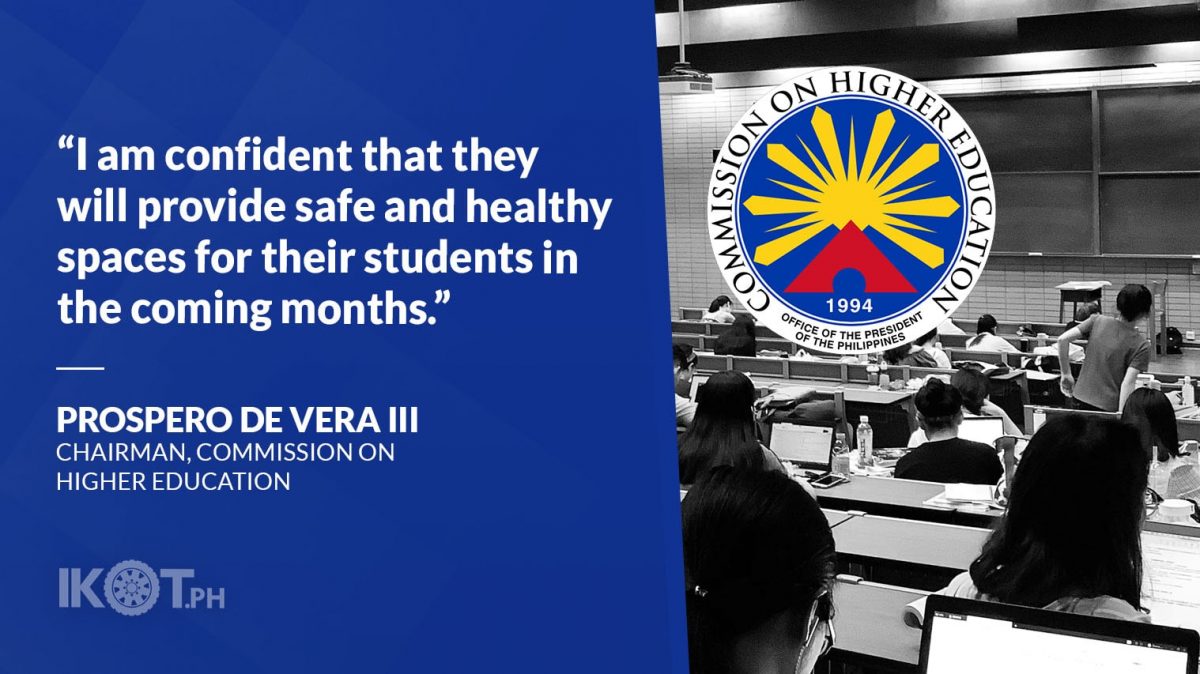Twenty-four higher education institutions (HEIs) all over the country can now hold limited face-to-face classes effective the 2nd Semester of AY 2020-2021.
“These HEIs have fully complied with the CHED-DOH guidelines and have been inspected by CHED and their LGUs so they can now bring their 3rd and 4th year students for hands-on training and laboratory classes in a limited face-to-face system. CHED will continue to monitor these HEIs and I am confident that they will provide safe and healthy spaces for their students in the coming months,” said CHED Chairman Prospero De Vera III.
The following HEIs passed stringent retrofitting and health standards imposed by CHED, the Department of Health (DOH) and the COVID-19 Inter-Agency Task Force for the Management of Emerging Infectious Diseases (IATF-EID):
1. Mariano Marcos State University – Batac (Region I)
2. St. Louis University (CAR)
3. Our Lady of Fatima University – City of San Fernando (Region III)
4. Ateneo School of Medicine and Public Health (NCR)
5. University of Santo Tomas (NCR)
6. University of East Ramon Magsaysay (NCR)
7. Our Lady of Fatima University – Quezon City (NCR)
8. Our Lady of Fatima University – Valenzuela City (NCR)
9. Manila Central University (NCR)
10. Adventist University of the Philippines (Region IV)
11. De La Salle Health and Medical Science Institute (Region IV)
12. University of Perpetual Help – Don Jose (Region IV)
13. Our Lady of Fatima University – Sta. Rosa (Region IV)
14. Naga College Foundation (Region V)
15. West Visayas State University (Region VI)
16. Central Philippine University (Region VI)
17. Cebu Institute of Medicine (Region VII)
18. University of Cebu School of Medicine (Region VII)
19. Iloilo Doctors’ College of Medicine (Region VI)
20. University of Iloilo (Region VI)
21. Blancia Foundation College, Inc. (Region IX)
22. Xavier University (Region X)
23. Liceo de Cagayan University (Region X)
24. University of the Philippines-Manila (NCR)
Selected allied health-related degree programs were prioritized to conduct limited face-to-face classes.
Selected allied health-related degree programs, such as Medicine, Nursing, Medical Technology/Medical Laboratory Science, Physical Therapy, Midwifery, and Public Health were prioritized to conduct limited face-to-face classes for two major reasons:
(1) To enable students to achieve key learning outcomes on specialized laboratory courses and hospital-based clinical clerkship/internship/practicum and
(2) to provide additional manpower to the country’s health system.
Since these schools have retrofitted facilities and are safe spaces, six (6) HEIs have partnered with their local government by allowing their facilities to serve as vaccination centers during the first wave of vaccinations:
1. University of Santo Tomas Hospital (NCR)
2. Manila Central University Gymnasium (NCR)
3. St. Louis University Baguio Gymnasium (CAR)
4. De La Salle Medical Health Sciences Institute (Region 4)
5. Our Lady of Fatima University (NCR)
6. Central Philippine University (CPU)
“We are encouraging the other HEIs to also offer their facilities as the country gears for expanded vaccination of senior citizens, essential workers, teachers and government personnel starting the 2nd quarter of the year. In return, we ask the LGUs to include the HEI faculty, staff and students who are assisting in the vaccination drive in their vaccination list so they can assist their LGUs,” De Vera said.
“Our HEIs can help in the government’s vaccination program.”
“This is also the reason why President Duterte approved limited face-to-face classes – because our HEIs can help in the government’s vaccination program,” the higher education chief stressed.
“As the country looks forward to receiving the next batch of millions of donated and procured vaccines in the 2nd quarter of the year, we must maximize the use of large alternative venues to be readily available so that the priority groups (essential workers, seniors, the indigents) could be inoculated without further delay,” the higher education head added.
He said that CHED is now preparing the Guidelines for Establishing Vaccination Centers in HEIs with inputs from the CHED Public Health Experts Group (PHEG).
These guidelines will be discussed with the LGUs and IATF and can be used in ensuring more vaccination centers for the government.

